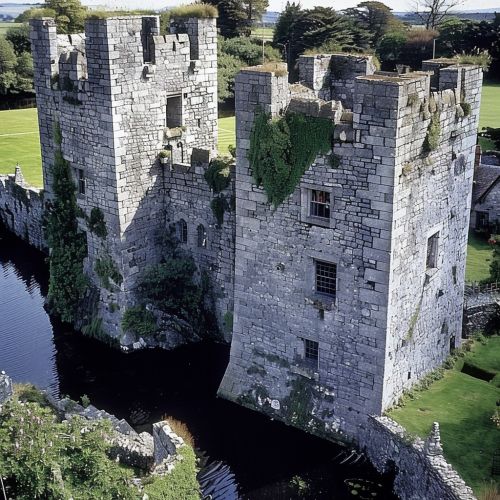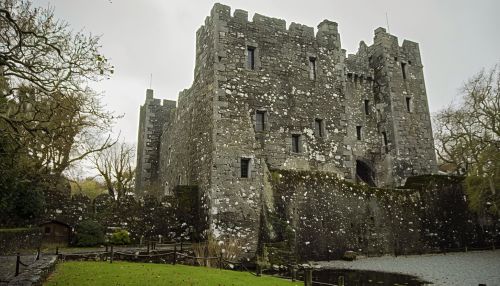Earls of Desmond: Difference between revisions
(Created page with "== Origins of the Earldom == The Earls of Desmond were a prominent noble family in Ireland, originating from the Anglo-Norman Fitzgerald dynasty. The title was created in the 14th century and was associated with the province of Munster, particularly the counties of Limerick, Kerry, and Cork. The Fitzgeralds, also known as the Geraldines, were initially granted lands in Ireland following the Norman invasion in the late 12th century. The...") |
No edit summary |
||
| Line 3: | Line 3: | ||
The [[Earls of Desmond]] were a prominent noble family in Ireland, originating from the Anglo-Norman Fitzgerald dynasty. The title was created in the 14th century and was associated with the province of Munster, particularly the counties of Limerick, Kerry, and Cork. The Fitzgeralds, also known as the Geraldines, were initially granted lands in Ireland following the [[Norman invasion of Ireland|Norman invasion]] in the late 12th century. The earldom itself was established by Maurice FitzGerald, who became the 1st Earl of Desmond in 1329. | The [[Earls of Desmond]] were a prominent noble family in Ireland, originating from the Anglo-Norman Fitzgerald dynasty. The title was created in the 14th century and was associated with the province of Munster, particularly the counties of Limerick, Kerry, and Cork. The Fitzgeralds, also known as the Geraldines, were initially granted lands in Ireland following the [[Norman invasion of Ireland|Norman invasion]] in the late 12th century. The earldom itself was established by Maurice FitzGerald, who became the 1st Earl of Desmond in 1329. | ||
[[Image:Detail-91563.jpg|thumb|center|Desmond Castle, a medieval stone castle with battlements and a surrounding moat.|class=only_on_mobile]] | |||
[[Image:Detail-91564.jpg|thumb|center|Desmond Castle, a medieval stone castle with battlements and a surrounding moat.|class=only_on_desktop]] | |||
== Political Influence and Power == | == Political Influence and Power == | ||
Latest revision as of 16:41, 20 June 2024
Origins of the Earldom
The Earls of Desmond were a prominent noble family in Ireland, originating from the Anglo-Norman Fitzgerald dynasty. The title was created in the 14th century and was associated with the province of Munster, particularly the counties of Limerick, Kerry, and Cork. The Fitzgeralds, also known as the Geraldines, were initially granted lands in Ireland following the Norman invasion in the late 12th century. The earldom itself was established by Maurice FitzGerald, who became the 1st Earl of Desmond in 1329.


Political Influence and Power
The Earls of Desmond wielded significant power in medieval Ireland, often acting as quasi-independent rulers within their territories. They maintained a stronghold in Munster, where they built numerous castles and fortifications, such as Desmond Castle in Kinsale. The earls were known for their military prowess and frequently engaged in conflicts with both rival Irish clans and the English Crown.
The Geraldines' influence extended beyond military might; they were also patrons of the arts and culture. The Desmond School of Poetry, for example, was renowned for its contributions to Irish literature and the preservation of Gaelic traditions. The earls' support for the Bardic tradition helped sustain a vibrant cultural life in their domains.
Conflicts with the English Crown
The relationship between the Earls of Desmond and the English Crown was complex and often contentious. While the earls were initially loyal to the Crown, their increasing autonomy and power led to tensions. The Desmond Rebellions, which took place in the late 16th century, were a series of uprisings led by the earls against English rule. These rebellions were fueled by a combination of political, economic, and religious factors.
The first Desmond Rebellion (1569-1573) was sparked by the Crown's attempts to impose English law and governance in Munster, which threatened the traditional Gaelic way of life. The second rebellion (1579-1583) was more extensive and devastating, culminating in the defeat of the Geraldines and the execution of the 15th Earl of Desmond, Gerald FitzGerald. The aftermath of these rebellions saw the confiscation of Desmond lands and the decline of the earldom's power.
Decline and Legacy
The fall of the Earls of Desmond marked a significant shift in Irish history. The confiscated lands were redistributed to English settlers, leading to the Plantation of Munster. This colonization effort aimed to establish a loyal Protestant population in the region, further eroding the traditional Gaelic aristocracy.
Despite their decline, the legacy of the Earls of Desmond endures in Irish history and culture. The Geraldines are remembered for their contributions to the arts, their resistance against English domination, and their role in shaping the political landscape of medieval Ireland. The ruins of their castles and fortifications remain as historical landmarks, attracting visitors and scholars interested in Ireland's rich past.
